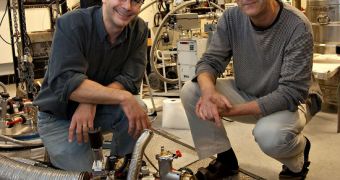A group of investigators from the Dartmouth College announces the discovery of an instance when processes going on at the quantum level take preeminence over those happening at the macroscale. While this has been noticed in other studies to take place under very specific conditions, the event is still extremely rare. Quantum interactions and processes usually take place at the sub-atomic level, where elementary particles interact.
“One major question in physics has to do with the connection between the microscopic and macroscopic worlds,” explains Dartmouth College associate professor of physics Alex Rimberg. Determining the interactions that develop between “classical” and quantum physics has been one of the most long-standing goals in this field of research. The famous debate between Albert Einstein and Niels Bohr began more than 70 years ago, and it still rages on to this day, the US National Science Foundation (NSF) reports.
What the Dartmouth team did was find a way to describe one of these events in detail. In a paper published in the July 1 issue of the esteemed scientific journal Nature, the team explains that the basis of their work was the theory of Nobel Laureate Werner Heisenberg, who discovered the Uncertainty Principle back in 1927. The idea refers to the fact that the momentum and position of an elementary particle such as an electron cannot be determined at the same time.
“To do a measurement, an experiment has to interact with whatever is being measured. But interaction means ultimately that you must exert a force on what you're measuring. If you're trying to measure the position of an object, any measurement will make the object move in an unpredictable and random way. This tendency to randomly affect what you are measuring is called 'backaction',” explains Rimberg. His team basically managed to demonstrate that such quantum world events can influence the macroscopic world. Generally, the term is given to whatever is visible to the naked eye.
The groups constructed a “quantum point contact” (QPC) device, which is basically a gateway for elementary particles. The QCP looks like a beak in the middle of a chip, only a few hundred micrometers across. It was created by depositing electrical gates made out of gold on the chip, which was actually a very small semiconductor crystal.
“You can think of the QPC as a tunnel barrier, sort of a wall for electrons. When the wall is sufficiently high, the electrons do not have enough energy to go over it. If electrons were classical objects, that would be the end of the story. But since electrons obey the laws of quantum mechanics, instead of going over the barrier they can also 'quantum tunnel' through it,” Rimberg says.
“The study of these kinds of systems advances fundamental knowledge and also addresses some very practical questions, including: What are the fundamental limits of measurement? And what is the most sensitive measurement device that can be made? Questions of this kind become more pressing as our science and technology shrink to ever smaller scales with the vision of devices, electronic and mechanical, that are perhaps only a few atoms in one or more dimensions,” concludes NSF Division of Materials Research (DMR) project manager Daryl Hess. The DMR funded the work.

 14 DAY TRIAL //
14 DAY TRIAL //